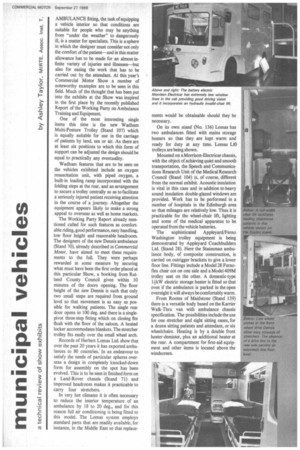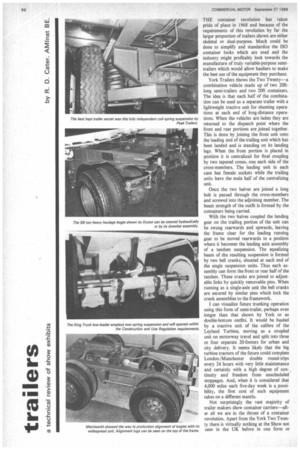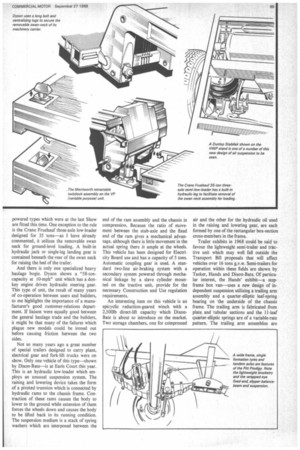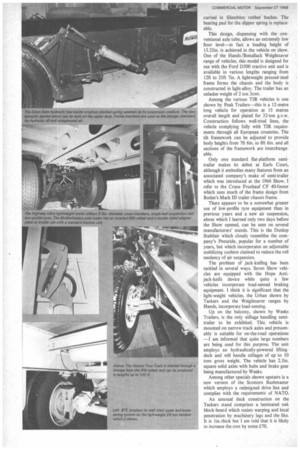AMBULANCE fitting, the task of equipping a vehicle interior so
Page 97

Page 98

Page 99

Page 100

Page 101

Page 102

If you've noticed an error in this article please click here to report it so we can fix it.
that conditions arc suitable for people who may be anything from "under the weather" to dangerously ill, is a matter for specialists. This is a sphere in which the designer must consider not only the comfort of the patient—and in this matter allowance has to be made for an almost infinite variety of injuries and illnesses—but also for easing the work that has to be carried out by the attendant. At this year's Commercial Motor Show a number of noteworthy examples are to be seen in this field. Much of the thought that has been put into the exhibits at the Show was inspired in the first place by the recently published Report of the Working Party on Ambulance Training and Equipment.
One of the most interesting single items this time is the new Wadham Multi-Posture Trolley (Stand 107) which is equally suitable for usc in the carriage of patients by land, sea or air. As there are at least six positions to which this form of support can be adjusted the design should be equal to practically any eventuality.
Wadham features that are to be seen on the vehicles exhibited include an oxygen resuscitation unit, with piped oxygen, a built-in loading ramp incorporated with the folding steps at the rear, and an arrangement to secure a trolley centrally so as to facilitate a seriously injured patient receiving attention in the course of a journey. Altogether the equipment appears likely to make a strong appeal to overseas as well as home markets.
CI) The Working Party Report already mentioned called for such features as comfortable riding, good performance, easy handling, low floor height and reasonable headroom. The designers of the new Dennis ambulance (Stand 70), already described in Commercial Motor, have aimed to meet these requirements to the full. They were perhaps rewarded in some measure by securing what must have been the first order placed at this particular Show, a booking from 'lut
a) land County Council given within 10 minutes of the doors opening. The floor height of the new Dennis is such that only two small steps are required from ground level so that movement is as easy as possible for walking patients. The single rear door opens to 100 deg. and there is a singlepivot three-step fitting which on closing fits flush with the floor of the saloon. A heated locker accommodates blankets. The stretcher trolley fits easily over the small wheel arch. Records of Herbert Lomas Ltd. show that over the past 20 years it has exported ambulances to 80 countries In an endeavour to seas a design in completely knocked-down form for assembly on the spot has been evolved. This is to be seen in finished form on .' satisfy the needs of particular spheres over a Land-Rover chassis (Stand 71) and
.22 improved headroom makes it practicable to
carry four stretchers.
In very hot climates it is often necessary to reduce the interior temperature of an In very hot climates it is often necessary to reduce the interior temperature of an
ct ambulance by 18 to 20 deg., and for this reason full air conditioning is being fitted to this model. The Lomas system employs standard parts that are readily available, for
instance, in the Middle East so that replace ments would be obtainable should they be necessary.
On its own stand (No. 136) Lomas has two ambulances fitted with mains storage heaters so that they are kept warm and ready for duty at any time. Lomas LIO trolleys are being shown.
Mounted on a Morrison-Electricar chassis, with the object of achieving quiet and smooth transportation, the Speech and Communications Research Unit of the Medical Research Council (Stand 104) is. of course, different from the normal exhibit. Acoustic insulation is vital in this case and in addition to heavy sound insulation double-glazed windows are provided. Work has to be performed in a number of hospitals in the Edinburgh area so that mileages are relatively low. Thus it is practicable for the wheel-chair lift, lighting and some of the medical apparatus to be operated from the vehicle batteries.
The sophisticated Appleyard/Ferno Washington trolley equipment is being demonstrated by Appleyard Coachbuilders Ltd. (Stand 28). Here the Statesman ambulance body, of composite construction, is carried on outrigger brackets to give a lower floor line. Fittings include a Model 28 Fernoflex chair cot on one side and a Model 409M trolley seat on the other. A domestic-type 11-kW electric storage heater is fitted so that even if thc ambulance is parked in the open overnight it will always be comfortably warm.
From Rootes of Maidstone (Stand 139) there is a versatile body based on the Karrier Walk-Thru van with ambulance chassis specification. The possibilities include the use for one stretcher and eight sitting cases, for a dozen sitting patients and attendant, or six wheelchairs. Heating is by a double front heater-demister, plus an additional heater at the rear. A compartment for first-aid equipment and other items is located above the windscreen. THE container revolution has taken pride of place in 1968 and because of the requirements of this revolution by far the larger proportion of trailers shown are either skeletal or dual-purpose. Much could be done to simplify and standardize the ISO container locks which are used and the industry might profitably look towards the manufacture of truly variable-purpose semitrailers which would allow hauliers to make the best use of the equipment they purchase.
York Trailers shows the Two Twenty—a combination vehicle made up of two 20ftlong semi-trailers and two 20ft containers. The idea is that each half of the combination can be used as a separate trailer with a lightweight tractive unit for shunting operations at each end of long-distance operations. When the vehicles are laden they are returned to the dispatch point where the front and rear portions are joined together. This is done by joining the front unit onto the leading end of the trailing unit which has been landed and is standing on its landing legs. When the front portion is placed in position it is centralized for final coupling by two tapered cones, one each side of the cross-members. The leading unit in each case has female sockets while the trailing units have the male half of the centralizing unit.
Once the two halves are joined a long bolt is passed through the cross-members and screwed into the adjoining member. The beam strength of the outfit is formed by the containers being carried.
With the two halves coupled the landing gear on the trailing portion of the unit can be swung rearwards and upwards, leaving the frame clear for the leading running gear to be moved rearwards to a position where it becomes the leading axle assembly of a tandem suspension. The equalizing beam of the resulting suspension is formed by two bell cranks, situated at each end of the single suspension units. Thus each assembly can form the front or rear half of the tandem. These cranks are joined to adjustable links by quickly removable pins. When running as a single-axle unit the bell cranks are secured by similar pins which lock the crank assemblies to the framework.
I can visualize future trunking operation using this form of semi-trailer, perhaps even longer than that shown by York or as double-bottom outfits. It would be hauled by a tractive unit of the calibre of the Leyland Turbine, moving as a coupled unit on motorway travel and split into three or four separate 20-footers for urban and city delivery. It seems likely that the big turbine tractors of the future could complete London /Manchester double round-trips every 24 hours with very little maintenance and certainly with a high • degree of con-, tinuity and freedom from unscheduled stoppages. And, when it is considered that 4,000 miles each five-day week is a possibility, the first cost of such equipment takes on a different mantle.
Not surprisingly the vast majority of trailer makers show container carriers—after all we are in the throes of a container revolution. Apart from the York Two Twenty there is virtually nothing at the Show not seen in the UK before in one form or another. Most of the interest in this field is in the methods of manufacture and in the various design details which have been thrown up largely as a result of the problems encountered with the early skeletal trailers.
Few makers now rely on the outrigger assembly which is simply welded onto the outside of the main frame-member. In nearly every vehicle the outrigger is now composed of substantial rolled-steel channel fab rications which pass across the complete width of the vehicle. It is interesting to note that many makers are utilizing steel press ings rather more liberally than in the past for fabrication of trailer frames. Where rather heavy rolled-steel members were the order of the day for the sundry bracketry used on many trailers, nearly every maker this year has employed a pressed section.
It is a fact that unladen weight has emerged as one of the most important sales factors in the trailer industry but trailer sales staffs tell me the haulier still looks for a very keen first cost as well. These two points are incompatible when thinking purely in terms of using light materials to produce a light vehicle.
Probably the biggest surprise is the 10ton-capacity, independent-coil spring sus pension shown by Peak Trailers. This unit utilizes a fabricated steel framework supporting swinging arms which are also fab ricated from rolledand pressedsteel sections. It is intended to produce this unit as a tandem suspension in the near future.
Although it is slightly more expensive than the conventional leaf-spring and tube-axle types, the Peak unit has a distinct advantage regarding unladen weight. The single-axle model on show is almost lcwt lighter than the conventional types.
Examples of well-constructed lightweights are on show on the Pitt and High way stands. But, where Pitt has concen trated on producing a vehicle aimed at capturing the extremely popular 24-ton market, Highway has aimed at a lightweight maximum-capacity unit. Pitt engineers set out to overcome two sore points found with single-axle, 24-ton trailers. Firstly these have proved awkward for delivery work and they have a critical axle-loading problem in that tractive unit rear and trailer axles must both be laden to their legal maximum (10 tons) in order that the full 24-ton g.v.w. is achieved. These cause the unit to lose time and leave the operator open to prosecution, and the Pitt Prodigy's design, which was first conceived to replace the company's All-Align oscillating axle model with a more stable machine, utilizes a lightweight tandem bogie.
The Highway lightweight is ingenious in its actual frame construction. The main frame webs are perforated with 8.5 in. holes at 211 centres and at every third hole a tubular cross-member is passed through, these being the same diameter as the holes.
This design results in an extremely stiff frame assembly which is also very light.
Single-leaf tandem suspension and low-pro file tubeless tyres go to making up the rest of the lightweight chassis construction.
Also, in mounting the bodywork, Highway has chosen to use light-alloy cross-bearers and a plywood floor.
Of all the low-loaders shown, Taskers display the only one employing twin oscillating knock-out axles at the rear end. Of the three heavy transporters shown by Dyson, Crane Fruehauf and King Truck two are of the double-drop-frame type and one is a semi-low-loader with three axles mounted on small wheel and tyre equipment.
It is inteiresting that both Dyson and Crane have employed front-end loading, a feature almost unknown in the UK a few years ago. The King Truck unit is even more sophisticated in that both the bogie and the swan neck of the trailer are removable for loading and the bed can be lowered to the ground. All three of these vehicles can operate within the Construction and Use Regulations requirements at certain gross vehicle weights. One of the features of the King unit is that the bed, being completely removable, allows spare beds to be used so that the vehicles can be operated with several beds and, for instance, avoiding lengthy delays when waiting for lifting gear.
While on the subject of special vehicles, mention must be made of the only pole trailer on show. Exhibited by Multiwheeler, the special vehicle division of Highway Trailers Ltd., this unit employs the Germanmade Eidal suspension. This assembly has two inverted leaf-springs forming a sprung trunnion-bogie and allowing for a considerable degree of oscillation when crossing bad ground—it also gives a very high ground clearance. The fifth-wheel of the Multiwheeler pole trailer is inverted; that is to say the actual fifth-wheel is carried upside down as a permanent fitting to the semitrailer, while the king-pin is mounted on a fixed rubbing plate fitted to the tractive unit. In order that the trailer can be recovered in the event of its own tractive unit breaking down, Multiwheeler has produced a double-sided rubbing plate which has a king-pin on both sides. In operation this adaptor is slipped onto the fifth-wheel of the standard tractive unit when the upper kingpin locks into the inverted fifth-wheel of the trailer. Bolsters are fitted to the turntable assembly and to the bogie which is arranged to operate in a number of positions along the pole.
There are two 24-ton g.v.w. dump-trailers at the Show, one on the Northern Trailers stand and the other on the Neville stand_ Both these vehicles herald a new era in the tipping world, where vehicles are required to operate both on and off the road. Both are frameless and employ the Villiers tipping system.
The two forms of tipping trailer on show highlight a swing to articulation for this type of vehicle. For the on-the-road bulk carriage of goods, the 30/32-ton tipper with very high straight frame and body tipped around its rear hinges seems to be competing favourably with those employing the Villiers system of tipping about the rear axles. The semi-trailer is also becoming the slave of the specialist body builder, particularly those concerned with bulk handling units.
Although the additional length of the 15-metre outfits is obviously going to give rise to problems when delivered to some older premises, there seems to be little swing towards the steering or steered bogies. Dyson, Northern and Hoynor all show steering bogies but in place of the three-axle unit on which steering axles were shown at the 1966 Show, Dyson's exhibit shows its Viberti tracking axle fitted to a twin-tyred widespread tandem.
Northern once again shows a three-axle bogie with a Ceschi tracking axle. Up on the balcony Hoynor has on show, for the first time at an exhibition, the Hoynor True Track three-axle semi-trailer on which all three axles are steered through a linkage from the king-pin. This is the only steered semi-trailer-----as opposed to special bogies and the like—which is on show and could possibly point the way to better manoeuvrability of the longer vehicles.
The widespread bogie in its straightforward form with fixed axle is found on a number of stands. It appears the industry has resigned itself to the fact that some sacrifice must be made to obtain the 32 tons g.v.w. on four axles and that the least painful side effect is the tyre scrub which the wide spread inevitability sets up. Of particular interest to me is the widespread unit shown by Merriworth. This was constructed in the company's unitized system, using steel pressings for the frame, and highlights the need for production methods to permit economical construction of trailers. Centralizing lugs on the top of the frame permit the running gear to be quickly placed in a position without any attention being given to alignment, this having already been covered in the sub-assembly shop which produces the running gears.
Although there appears to be little in the way of standardization of braking systems among tractive units at the Show, the semi-trailer makers seem to have arrived at a fairly standard sort of layout. With the exception of the use of spring brakes or a triple diaphragm secondary system, no alternatives are offered in the number of axles braked.
No special landing gears are on show this year. Although singleand two-speed units are shown none of the sophisticated powered types which were at the last Show are fitted this time. One exception to the rule is the Crane Fruehauf three-axle low-loader designed for 35 tons—as I have already commented, it utilizes the removable swan neck for ground-level loading. A built-in hydraulic jack or single-leg landing gear is contained beneath the rear of the swan neck for raising the bed of the trailer.
And there is only one specialized heavy haulage bogie. Dyson shows a "58-toncapacity at 10-mph" unit which has a donkey engine driven hydraulic steering gear. This type of unit, the result of many years of co-operation between users and builders, to me highlights the importance of a manufacturer's good customer-relations department. If liaison were equally good between the general haulage trade and the builders, it might be that many of the failures which plague new models could be ironed out before causing friction between the two sides.
Not so many years ago a great number of special trailers designed to carry plant, electrical gear and fork-lift trucks were on show. Only one vehicle of this type—shown by Dixon-Bate—is at Earls Court this year. This is an hydraulic low-loader which employs an unusual suspension system. The raising and lowering device takes the form of a pivoted trunnion which is connected by hydraulic rams to the chassis frame. Contraction of these rams causes the body to lower to the ground while extension of them forces the wheels down and causes the body to be lifted back to its running condition. The suspension medium is a stack of spring washers which are interposed between the
end of the ram assembly and the chassis in compression. Because the ratio of movement between the stub-axle and the &Iced end of the ram gives a mechanical advantage, although there is little movement in the actual spring there is ample at the wheels. This vehicle has been designed for Electricity Board use and has a capacity of 5 tons. Automatic coupling gear is used. A standard two-line air-braking system with a secondary system powered through mechanical linkage by a slave cylinder mounted on the tractive unit, provide for the necessary Construction and Use regulation requirements.
An interesting item on this vehicle is an epicyclic reduction-geared winch with a 2,5001b direct-lift capacity which DixonBate is about to introduce on the market. Two storage chambers, one for co:impressed air and the other for the hydraulic oil used in the raising and lowering gear, are each formed by one of the rectangular box-section cross-members in the frame.
Trailer exhibits in 1968 could be said to favour the lightweight semi-trailer and tractive unit which may well fall outside the Transport Bill proposals that will affect vehicles over 16 tons g.v.w. Semi-trailers for operation within these fields are shown by Tasker, Hands and Dixon-Bate. Of particular interest, the Hands' exhibit—a stepframe box van—uses a new design of independent suspension utilizing a trailing arm assembly and a quarter-elliptic leaf-spring bearing on 'the underside of the chassis frame. The trailing arm is fabricated from plate and tubular sections and the 11-leaf quarter-elliptic springs are of a variable-rate pattern. The trailing arm assemblies are
carried in Silentbloc rubber. bushes. The bearing pad for the slipper spring is replaceable.
This design, dispensing with the conventional axle tube, allows an extremely low floor level—in fact a loading height of 13.25in. is achieved in the vehicle on 'show. One of the Hands /Bonallack Weights aver range of vehicles, this model is designed for use with the Ford D300 tractive unit and is available in various lengths ranging from 12ft to 25ft 7in. A lightweight pressed-steel frame forms the chassis and the body is constructed in light-alloy. The trailer has an unladen weight of 2 ton 3cwt.
Among the various TIR vehicles is one shown by Peak Trailers—this is a 12-metre long vehicle for operation at 15 metres overall length and plated for 32-ton g.v.w. Construction follows well-tried lines, the vehicle complying fully with TIR requirements through all European countries. The tilt framework can be adjusted to provide body heights from 7ft 6in. to 8ft 6in. and all sections of the framework are interchangeable.
Only one standard flat-platform semitrailer makes its debut at Earls Court, although it embodies many features from an associated company's make of semi-trailer which was introduced at the 1966 Show. I refer to the Crane Fruehauf CF 40-footer which uses much of the frame design from Bode,n's Mark III trailer chassis frame.
There appears to be a somewhat greater use of low-profile tyre equipment than in previous years and a new air suspension, about which I learned only two days before the Show opened, can be seen on several manufacturers' stands. This is the Dunlop Stabilair which closely resembles the company's Pneuride, popular for a number of years, but which incorporates an adjustable stabilizing cushion claimed to reduce the roll tendency of air suspension.
The problem of jack-knifing has been tackled in several ways. Seven Show vehicles are equipped with the Hope Antijack-knife device while quite a few vehicles incorporate load-sensed braking equipment. I think it is significant that the light-weight vehicles, the Urban shown by Task ers and the Weightsaver ranges by Hands, incorporate load-sensing.
Up on the balcony, shown by Weeks Trailers, is the only stillage handling semitrailer to be exhibited. This vehicle is mounted on narrow track axles and presumably is suitable for on-the-road operations —I am informed that quite large numbers are being used for this purpose. The unit employs an hydraulically-powered liftingdeck and will handle stillages of up to 10 tons gross weight. The vehicle has 2.5in. square solid axles with hubs and brake gear being manufactured by Weeks.
Among other specials shown upstairs is a new version of the Scottorn Bushmaster which employs a redesigned drive line and complies with the requirements of NATO.
An unusual deck construction on the Taskers stand comprises a laminated oak block-board which resists warping and local penetration by machinery legs and the like. It is lin. thick but I am told that it is likely to increase the cost by some £70.
































































































































































































